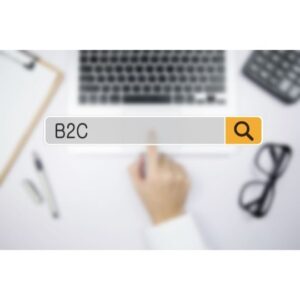Business to Consumer -Knowing your target market is critical for any business that wants to sell and flourish. While some firms prefer to deal with other businesses, the vast majority prefer to do business with their end customers directly.
What exactly is Business-to-Consumer (B2C)?

Business to Consumer (B2C) is a manner of doing business in which enterprises trade and transact directly with end customers who purchase products for consumption.
Unlike B2B customers, these customers do not use the exchanged product to improve their offering or to resell for profit.
Here’s an illustration:
Consider the example of a fast-food restaurant. This company is supposed to follow the B2C model because it services customers and people rather than other businesses.
A firm that produces value for customers and individuals is said to operate on a Business to Consumer (B2C) model. That is not to suggest that a B2C company just serves customers. A B2C company may also assist other businesses, but its primary concentration is on directly serving consumers and individuals.
7 Ways to Ensure That Your Customers and Clients Pay You
Business-to-Business (B2B)
B2C, or Business to Consumer, is a business paradigm in which enterprises serve customers rather than other businesses, as opposed to B2B.
This leads us to –
The various sorts of B2C models.
Models of Business-to-Consumer (B2C)
Because the B2C model is wide and complex, let’s take a look at a few common and mainstream forms –
B2C Model Based on Products
Businesses offer items to consumers in the product-based B2C paradigm. The company could function as a supplier, selling customised products to individuals through their own physical or online stores.
A shoe brand selling its shoes to customers through a physical storefront is an example of a product-based B2C enterprise. Adidas is an excellent example of a B2C shoe firm that manufactures and sells its branded shoes to consumers and people through its online and physical stores, as well as through ecommerce sites.
B2C Model Based on Services
A business with a service-based B2C model does precisely what its name implies: it assists in the provision of services to its customers. Instead of selling tangible things, a service-based B2C company generates money by offering services.
A lawn mowing service is an example of a service-based B2C business.
Service-based B2C businesses are numerous and significant because they require less initial investment and are easy to scale up as needed. Furthermore, service-based B2C businesses are easier to set up and maintain than product-based B2C firms.
The service-based economy B2C companies may have an online, physical, or both presence, but it all comes down to the service that the company offers.
LinkedIn Can Help You Find Work in 10 Ways You Didn’t Know About
B2C Model Based on Software

Software-based B2C businesses can be classified as “product” or “service” based. While the latter is concerned with offering software services to consumers, the former is concerned with providing software solutions and products. The software-based B2C model is generally divided into —
.B2C software-based “product-focused” model
.B2B software-based “service-focused” model
“Product-Focused” B2C Software Model
Adobe and Microsoft are two excellent examples of “product-focused” software-based B2C businesses. They sell software tools to consumers for editing and creating media and documents, respectively.
B2B software-based “service-focused” model
Netflix and Spotify are two excellent instances of “service-focused” software-based B2C businesses. Through the use of software, both contribute to the provision of video and music services to consumers.
These services are typically dependent on membership or subscription. The services may be quickly deployed as needed, making them much more scalable than software products.
While these are some of the most common forms of B2C models, there is one more that deserves its own category: the online B2C model.
Online B2C Business Models
B2C Model Based on Advertising
The advertising-based B2C model involves online sites using content to bring visitors – this might be a website, blog, or forum – and earning cash by displaying advertisements on the site.
Advertising-based B2C enterprises include high-volume sites like news magazines and tech websites like The Huffington Post and TechCrunch.
Community-Based Business-to-Consumer (B2C) Model
Social media networks are excellent examples of community-based online B2C enterprises. Consider Facebook: it connects and builds online communities among its users, who then utilise the platform to sell their products and generate money.
Consumer-to-Consumer Ecommerce
Businesses offer (and buy) things to customers and individuals through B2C ecommerce. This is made possible through the use of online markets and stores. B2C e-commerce is a significant field in the B2C model and is divided into two distinct sub-models. They are called –
.Direct sellers – In this arrangement, buyers buy goods directly from manufacturers through their online merchants. Supreme’s Online Store is one example.
Benefits of the B2C Model
A Broad and Diverse Market
In comparison to B2B, the B2C market is far larger and more diverse. While the specialisation in B2B has a restricted number of clients, B2C enterprises have the advantage of addressing a wider number of consumers. Even if you plan to target a niche B2C market, this figure is rather significant.
Simpler Expansion
Expansion of a B2B business necessitates significant investment and overhead. B2C, on the other hand, is considerably easier to develop into new niches and markets — whether vertically or horizontally.
Marketing Made Simple
Individuals are considerably easier to advertise to than other businesses. B2C businesses can simply increase revenue and attract new consumers by utilising social media and content marketing.
Data-Driven

Unlike the B2B sector, where it is typically more difficult to gather and use data to forecast emerging trends, the B2C sector has no shortage of data if correctly applied. Each individual is a data mine, and when used correctly, this data can enable the B2C organisation acquire a significant competitive advantage.
The Drawbacks of the B2C Model
Increased Competition
In comparison to B2B, B2C is the most prevalent sort of business that gets started. This is owing to the lower overheads associated with launching and operating a B2C. When compared to a B2B firm, this means that there is a lot of rivalry within the same field for the same product.
Reduced Margin
In contrast to B2B, the products offered and their prices are negligible in B2C. So, one method to make up for lost revenue is to prioritise number above quality. This increases the danger of not being able to recoup enough to keep the firms running in the event of poor sales levels.
Middlemen’s Presence
The B2C market is filled with intermediaries that mark up products and sell them at a higher price. As a result, consumers must pay a higher rate than intended. Aside from that, this creates a schism between customers and businesses. It also makes it more difficult for companies to obtain useful client data that can be utilised to improve their product and increase sales.
Market Segmentation
The B2C market is larger and more diverse, but it is also more segmented. Because of the enormous amount of sectors available for firms to evaluate, timely decision making is hampered.
To have a better idea, consider a few examples of B2C businesses.
